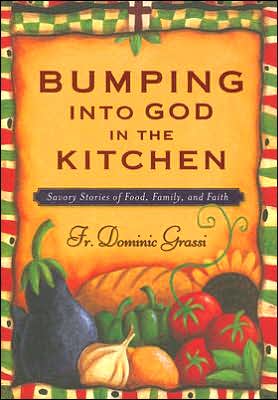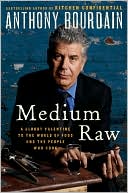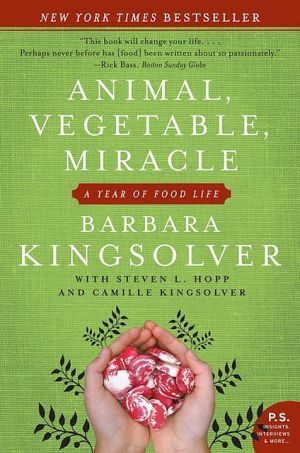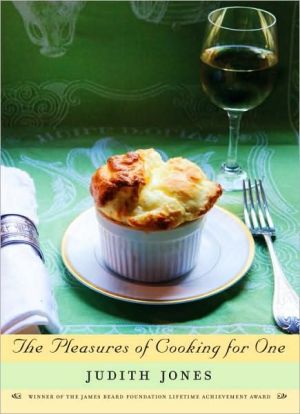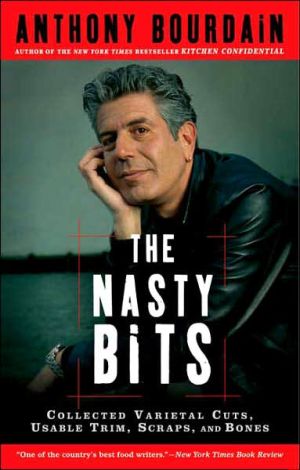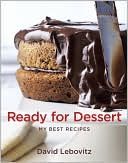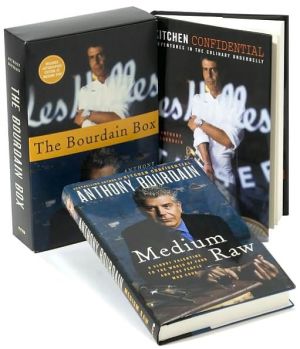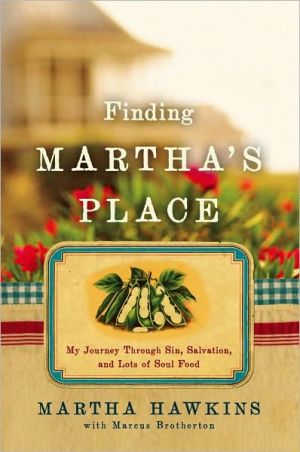Bumping into God in the Kitchen: Savory Stories of Food, Family, and Faith
God is everywhere—including the kitchen! Just ask Fr. Dominic Grassi, ardent gourmand, amateur chef, and full-time pastor on Chicago's North Side. Fr. Grassi has long been stirred by the combination of good food and good stories, and Bumping into God in the Kitchen showcases his literary and culinary talents through 50 poignant, funny, inspiring, and at times educational stories.\ Each of these personal stories in some fashion reminds us that God is everywhere that food can be found. And...
Search in google:
Introduction\ It is a story I love to tell. I use it quite often on talks that I give. I’ve used it in my writing many times And it fits so well here as an introduction to the third installment of my stories, reflections, and reminiscences, the first two called Bumping into God and Bumping into God Again. This one, as you ascertained from the cover, is entitled Bumping into God in the Kitchen. I know what you are thinking, so let me categorically state that there will not be future volumes dealing with various other rooms of the house. I could stretch and imagine Bumping into God in the Laundry Room. But the line has to be drawn somewhere. Still, why choose the kitchen as a focus for this group of stories?\ A number of years ago, I gave a series of talks at a parish that was being formed by three parishes merging together. Breakfast was going to be served during the break after my first presentation. As I was speaking, tray after tray of bagels and donuts and sweet rolls were being set up behind those who were intently listening to me. Bowls of fruit salad were carted in. Juice and coffee were brought out. After so many years of public speaking, I am amazed at how easily I can continue to talk while in my mind I am selecting my roll and what kind of cream cheese I want. The talk completed, I rushed to the back and made sure I got what I had mentally selected.\ As I stood back up at the podium, enjoying the food I had rushed to get, a woman approached me. She had been taking copious notes during my talk. Even at this moment she had notebook and pen in hand, while everyone else was following my example at the food tables. She was well past middle age, and I guessed she had been very active in one of the three merging parishes. I smiled benignly at her, hoping there was no strawberry cream cheese stuck to my teeth.\ She responded to my smile with a quick, business-like one of her own. “I just have an observation about your presentation,” she stated. Before I could decide if the tone of her voice was friendly or hostile, she continued, “You sure do eat a lot in your parish.” I wasn’t sure if she was approving of the examples I had used, ranging from New Parishioners Dinners to Leadership Brunches to the Unity Ball and Dinner. I had also mentioned “hospitality in the park” after Masses, our International Dinner, and many other examples from the parish in which I was pastor at the time. A little unsure of myself, I simply responded, “They say a parish reflects its pastor.” She gave me that same smile and walked back to her table and kept on writing. She never did go to the refreshment table.\ Not only did the parish of St. Josaphat in Chicago reflect me, but clearly so has much of my writing over the years. As one woman said at a book signing for my second book, “Father, your stories always make me hungry!” I hope that at least some of that hunger is of a spiritual variety.\ Yes, food has a dominant role in many of the stories I share, and thus in the books I write. That is part of my Italian heritage. Check my DNA and you’ll find tomato sauce. One radio show I was on ended with the interviewer graciously comparing my books to the famous Chicken Soup series. I said with typical Italian bravado, “Who needs chicken soup when they can have lasagna?”\ So in their wisdom, the great folks at Loyola Press decided Why fight it? and asked me to write a collection of stories more specifically about food and feasting. What makes this book different from the previous two is that food moves to center stage. Included are recipes for a complete Italian meal, from antipasto to dolci (or from beginning to end, for those of you not related to the Caesars).\ Some of the recipes are classics that my mother made for decades. She passed them on through my brother Tony, who sat her down in his own kitchen and had her walk him through the recipes. He would follow her instructions and then write them down. Other recipes in this book are versions of what she cooked that my brother Phil and his wife, Donna, and my brother Joe and I have adapted over the years. We seem to have inherited much from our mother, including our ability to cook in large quantities.\ Our memories are often stirred by our senses—looking at a picture, smelling a flower, listening to music. For me—and, I venture to think, for many others—tasting certain foods again after many years, or even yesterday, can make moments that were special in our lives vivid again. These feasts or simple meals or coffee breaks shared with others become moments of grace, during which we bump into God and feel God’s unconditional love in our lives. When shared, they become the stories of our lives. And when we share those stories over good food, generously served with love, we create yet more moments of grace and more stories to tell.\ The writing of this book happened to coincide with the death of my mother and my departure after eighteen years from St. Josaphat Parish. Perhaps these events add a “bittersweet” flavor, which you will taste in some of these stories. But mourning is as much a part of life as celebrating and eating are. Sometimes all three can happen simultaneously. What I have come to realize is that we are who we are. We experience and deal with what life sends our way, with our own experiences of and faith in a loving God to help us through. Those blessings, like the memory of a loved one shared during a good meal, will never be taken away from us, especially if we continue to celebrate them by remembering them and sharing them.\ These are my stories and recipes. I genuinely hope that they make you hungry, both spiritually and physically. If they do, try them out. Don’t be a slave to them. Make them your own. I hope they will become catalysts for you to start sharing your recipes and your stories. Jesus himself chose the setting of a meal to say, “Do this in memory of me.” A crucial aspect of our faith comes to us in the breaking of the bread. And so it is that we find ourselves bumping into God in the kitchen. It’s as good a place as any, and better than most.\ \ Antipasto\ \ You must make this pronouncement: . . .\ “He brought us here and gave us this land, a land where milk and honey flow. Here then I bring the first fruits of the produce of the soil that you, Yahweh, have given me.”\ You must then lay them before Yahweh your God, and bow down in the sight of Yahweh your God. Then you are to feast on all the good things Yahweh has given you, you and your household, and with you the Levite and the stranger who lives among you.\ Deuteronomy 26:5, 9–11\ Antipasto means “before the meal.” Cold or hot, these foods were served to fill you up before the more expensive main courses were served. Cured meats, cheeses of all sorts, seasonal vegetables served raw or grilled, and preserved or pickled vegetables were part of this common fare. This ordinary stuff was made special by the creativity of the cook. Expanded menus today include salads that, at some tables, are eaten with the main courses or after them. Sometimes even a simple pizza or bread with seasoned oil is served prior to the main course.\ A good antipasto selection can warm up not just the appetite but also the spirit, letting people know that they are welcome and that they won’t have to hold back: there will be more than enough for everyone. Pour a glass of wine and pass the dishes—the stories will begin and become a part of the meal, as they should.\ Quick Pickled Peppers\ This is Mom’s recipe that my brother adapted in order to fix the dish faster. My brother Phil serves it as an appetizer with crusty bread and chunks of Romano cheese or provolone. The peppers are also great on a sandwich with Genoa salami and mozzarella.\ \ Ingredients\ 1/2 cup light virgin olive oil\ 3 cloves garlic, halved\ 4 green bell peppers, cut in 1-by-2-inch pieces\ 1 red bell pepper, cut in 1-by-2-inch pieces\ 1 yellow or orange bell pepper, cut in 1-by-2-inch pieces Salt and pepper\ 3/4 cup red wine vinegar mixed with 1/4 cup water Fresh or dried basil\ Directions Cover the bottom of a large frying pan with the olive oil and place over medium heat. Add the garlic cloves to the oil.\ Decrease the heat to low and add the peppers, salt, pepper, and basil. Cover the pan.\ Cook for 15 minutes for crispy peppers, or longer if you desire softer peppers, turning halfway through cooking.\ Remove the peppers and place them in a bowl. Cover the bowl.\ Pour out all but a tablespoon of the oil from the pan. Add the vinegar and water to the pan and bring to a boil; cook for 3 to 4 minutes.\ Pour the heated vinegar and water over the peppers in the bowl, cover the bowl again, and refrigerate for a minimum of 2 hours, the longer the better.\ Mom’s Egg Balls\ Warning: these can be addictive and can fill you up quickly. They are great served warm or at room temperature. Leftovers can be thrown into your tomato sauce and served with pasta. Too much baking powder will create a monster; too little, and the egg balls will be flat and heavy. Two of my nieces have become pros in egg ball cooking. A tradition lives on.\ \ Ingredients\ 12 eggs\ 1 cup milk\ 1 cup breadcrumbs\ 1/2 cup grated Romano cheese Salt and pepper Fresh or dried basil Garlic powder\ 1 cup all-purpose flour Corn oil\ 1/3 cup olive oil\ 2 teaspoons baking powder\ Directions Whisk together the eggs and the milk, then add the breadcrumbs and the Romano cheese.\ Add salt, pepper, basil, and garlic powder to taste, then slowly add the flour. Let the mixture sit for 15 minutes.\ Heat 2 inches of corn oil in a frying pan over medium heat or in an electric skillet. Carefully sprinkle the olive oil on top of the slowly heating corn oil.\ Add the baking powder to the batter and mix again.\ Spoon one of the balls of batter into the hot oil, turning until golden brown. Adjust the heat and the seasonings if necessary. Fry the remaining balls of batter. Place the fried egg balls on paper towels to soak up excess oil.\ Serve immediately.\ My Own Sausage and Peppers\ I created this dish using ingredients I like; that’s the fun of cooking. This dish can be made ahead and reheated in the microwave. Add whatever ingredients you like, or modify those given here. This dish goes well with crostini or Italian breadsticks, and leftovers can be served in warm Italian bread, cut lengthwise and hollowed out.\ \ Ingredients\ 2 pounds sweet Italian sausage, cut into 1-inch cubes\ 1 pound hot Italian sausage, cut into 1-inch cubes\ 3 cloves garlic, minced\ 2 green bell peppers, julienned\ 1 red or orange bell pepper, julienned\ 1 yellow bell pepper, julienned\ 2 large sweet onions, sliced\ 1 small jalapeño pepper, diced Salt and pepper Balsamic vinegar\ Directions Fry the sausage in a large frying pan over high heat until cooked. Remove the sausage, leaving the fat in the pan, and drain on paper towels.\ Add the garlic, the peppers, the onions, and the jalapeño pepper to the fat in the pan. Add salt and pepper to taste.\ Cook ingredients until they just start to soften and then return the sausage to the pan.\ Immediately add enough vinegar to cover all the ingredients.\ Cover the pan with a lid, decrease the heat, and simmer until the onions start to get limp.\ Serve immediately or refrigerate and reheat.\ My Own Tomato-and-Bread Salad\ Italians have always found creative ways to use leftover bread. Here is mine. This is a simple and quick dish that can even be a light summer lunch. Keep in mind that too much liquid will make the bread soggy. Mixing the two vinegars gives the dish both a sweet and a tart taste. Add a little lemon juice, crumbled Gorgonzola cheese, and toasted pine nuts, and the dish becomes more of a meal. Toast the bread in the oven and rub it with garlic for a different taste. Adapt, add, change. Make it your own.\ \ Ingredients\ 5 or 6 ripe tomatoes, coarsely chopped\ 1 sweet onion, thinly sliced\ 4 or 5 fresh sweet basil leaves, torn into pieces Stale Italian bread, cubed, enough to almost fill the bowl used for serving Extra virgin olive oil Balsamic vinegar Red wine vinegar Salt and pepper\ Directions Combine the tomatoes, the onion, the basil leaves, and half of the bread in a bowl.\ In a separate bowl, mix equal parts olive oil, balsamic vinegar, and red wine vinegar. Pour the mixture into the bowl with the tomatoes while mixing the ingredients, leaving a trace of dressing at the bottom of the bowl. Add more bread as you like.\ Add salt and pepper to taste. Mix again. Refrigerate and serve cold.\ 1\ Sunday Pasta\ \ Most family meals were important when I was growing up. But unlike the families we saw on the television shows Father Knows Best and Leave It to Beaver, we didn’t gather for a big family dinner every night. Mom would feed her four sons, or any of us who were home, sometime around six o’clock. When she finished with us, she would get a meal ready for Dad, who arrived home from the grocery store around seven thirty—and much later on Fridays, when the store remained open until nine. She would always eat with him.\ Even though we did not all eat together during the week, our evenings had a definite routine. First of all, Dad did not want us to watch television before he arrived home from work. It seemed to us kids that he didn’t want us to enjoy the television if he couldn’t, but it probably had more to do with his perception that the old RCA console TV consumed a lot of electricity and our watching it would hike the utility bill. So we made sure to turn off the set early enough so that the tubes would cool down before Dad got home, in case he decided to check on us by touching the top of the set.\ Another part of our routine involved the chain-link fence that surrounded our backyard and the parking area. It had a double-wide gate, and whenever it was opened, a piece of metal on the bottom of it dragged on the ground, producing a scraping sound that could be heard in the house. Dad saw it as our duty to make certain the gate was open when he came home from work; this would save him the trouble of getting out of the car to do it. At the same time, he didn’t want the gate open too early, because he liked our yard to be secure.\ I can remember the feelings of dread that would come over my brothers and me when, on occasion, we lost track of time and our illegal TV-watching was interrupted by the sound of that back gate scraping open. Dad would storm into the house, mad because he’d had to get out of the car to open the gate. Then he would check the television set and find it still warm.\ Another evening routine developed that, as far as I can remember, involved only Dad and me when I was little. Given the right circumstances—which included the gate being open at the right time and the top of the television being cool—I would sit on Dad’s lap and look at his big hands. Surprisingly, they were not very calloused, even though he had done physical labor his whole life. My mother would say his hands were soft, like a baby’s. She told me that I had inherited my hands from him. Embedded in the skin of the fingers of his right hand were small flecks of metal. He told me that they were reminders of his years working in the coal mines of Pennsylvania. This fascinated me. I can’t count the number of times I asked him if those pieces of metal hurt. He would chuckle and say, “Not at all,” and I would press on them in awe.\ When I grew too old to sit on Dad’s lap, he would call me over to his chair before he sat down for dinner and say, “Dominic, loosen my shoes.” I would sit on the floor in front of him and untie the laces of his high-top work shoes until he would sigh with satisfaction. The truth is I didn’t mind this special task—he never asked my brothers, only me—until I was older and occasionally my friends would be present when Dad asked me to loosen his shoes. Out of the corner of my eye, I could see them trying to hide a smile, and it embarrassed me.\ After Dad finished eating dinner, he’d watch a little TV. He liked the fights, Perry Como (because he was Italian), and the news. He was in bed by ten thirty. I never saw him read a book or even the Chicago Tribune, which was delivered daily. He never talked to us about his day or asked us about ours. This was pretty much our weeknight routine.\ It was precisely this routine that made Sunday pasta so special. On Sundays after Mass, everyone was expected to be around the kitchen table. (The dining room was reserved strictly for holidays.) The choice of noodle would change—one week it would be rigatoni, the next week ziti—but the tomato sauce would always be the one Mom cooked for hours on Saturday. The table would be set with the free Watt Pottery terra-cotta dishes given out by the R&F Spaghetti Company, which are now worth hundreds of dollars to collectors.\ Cucumbers sliced into spears, sharp-tasting red radishes, and crisp celery stalks sat in bowls, giving off a fresh, earthy smell. Steaming bowls of pasta covered with the rich sauce and optional grated Romano or dry ricotta cheese were placed in front of everyone. A big bowl of meat that had been cooked in the sauce awaited us in the center of the table. This dish included meatballs, rolled and stuffed flank steak, neck bones, oxtails, lamb ribs, and occasionally pig’s feet, but we could not eat the meat until we had finished our pasta. A loaf or two of Gonnella twist bread was passed around, from which we would break off a piece to “spoonce in the soak,” which means “dunk in the sauce.” We drank Canada Dry Ginger Ale colored with a splash of dollar-a-gallon Petri Wine. Too much ginger ale would draw a look from Dad. He was always conscious of the food Mom took from the store to feed the family.\ It was during this Sunday meal that we talked as a family, though I confess I don’t remember what we talked about. But I do remember lots of laughter. On Sundays, Dad was usually more relaxed and less tired than during the week. After lunch, Mom did the dishes. Dad napped. My brothers and I went off to entertain ourselves.\ Sunday pasta offered us great comfort. We knew exactly what to expect, what we would see, smell, taste, hear, and feel. When I was feeling insecure as a child, the Sunday pasta routine calmed me and reminded me that everything would be just fine. I was safe, surrounded by my family and by the comforting smells and tastes that were so much a part of me that I could not put into words how much I craved them. There at the table, my past heritage and my present family pointed me toward a future with a potential I am still trying to appreciate. Around that table I learned the trust and the love that would bring me to where I am today.\ When I went off to seminary, the Sunday lunch was grand, with ham or roast beef or fried chicken. But I was never quite as hungry as I had been during those years before, because it wasn’t Sunday pasta around the kitchen table with the family. Only now, decades later, do I realize that what I hungered for was not so much the food as the spiritual nourishment the Sunday pasta represented. I think this understanding has made me a better priest, as I share God’s love around Jesus’ table with all who come. I want them to feel as safe and as loved as I did with my family when we shared Sunday pasta.\ 2\ Common Senses\ \ Very often when I give talks or conduct retreats or make presentations, or after someone has read one of my books, I am asked, “How do you remember all those stories with such detail?” At first I didn’t have an answer. Over time, however, I grew to realize what triggered my memories. And so now I respond, “It’s just common senses, that’s all.” Usually a story or a memory comes back to me or into clearer focus because of something I detect with one or more of my senses. The more I concentrate on what I am smelling or hearing or seeing or tasting, the clearer the memory and the more detailed the story. Here are some examples.\ I dislike the smell of roses, whether the flowers themselves or in perfume. That strong, sweet smell, so rich it almost takes my breath away, reminds me of my grandfather’s funeral, when I was seven years old. Suddenly I am standing once again in front of that stiff and altogether frightening body. I remember fearing that he would sit up and look at me. I can still see all the flowers around the coffin, most of them roses. The funeral parlor was too hot, and that thick scent almost made me swoon. I looked away from the corpse and saw another bouquet of roses around a clock face that indicated the time of death. Ever since, I have seen stopped clocks as bad luck for me, as harbingers of death. Roses at a wedding or on a dining room table or in a vase carry me back to that night, and each time I remember more details.\ Even touch can jog my memory. I can’t wear bulky sweaters of material that scratches my arms or neck. That feeling reminds me of a camel hair coat I wore when I was eight years old. It was a hand-me-down from one or two of my older brothers. The collar was frayed and scratched my neck. The lining in the sleeves was gone, and my arms itched and itched. Because the coat had no buttons by the time I got it, Mom would secure it with safety pins, so it was both uncomfortable and embarrassing to wear. I felt like a war orphan from the comic strips. Today, if my neck or arms itch from what I am wearing, I feel that everyone is laughing at me.\ Sometimes, hearing something can bring some long-\ ago experience rushing back. I don’t hear the old Western song “Red River Valley” much anymore, which is fortunate. When I was twelve, someone gave me a yellow LP of cowboy songs. It was the first LP I owned, and I thought it was pretty neat. My older brothers had their Elvis albums, and my parents had their Robert Alda (he was the father of the actor Alan Alda and sounded like Perry Como). And now I had my own record, which I played one Saturday morning, over and over on our De Forest TV/stereo console. Just as Gene Autry was singing, “Do not hasten to bid me adieu” to some pretty cowgirl who was leaving him, my brother Joe came downstairs and broke the record in half without saying a word. I went numb, and that feeling returns when I hear that song. But I also remember sneaking up to Joe’s room after that when he wasn’t there and scratching some of his records and tearing random pages from his art books. I wonder if he remembers any of that.\ Not all the memories are negative. I can’t help but grin when I see a picture of the Washington Monument. I remember standing in front of it during my senior class trip, the trip on which I’d flown on an airplane for the first time. My friends and I were looking at the Washington Monument when one of our teachers announced—he’d just gotten word—that I had won second place in a national contest for yearbook writing. My career as a writer had begun. I felt grown up and successful. Now when I get writer’s block, I just pull out a picture of the monument and I can write again.\ You probably already suspect that my most heightened sense is taste. Food plays an important role in my life, and I know that much of the joy I get from food is connected to memory. That moment when raw ingredients are transformed into a genuine tomato sauce thickening and simmering on the stove is special to me. Mom would not let me dunk bread into sauce that had already been cooking for a couple of hours: she feared the crumbs might sour her sauce, which still had a ways to go. So I waited for her okay. When it was time, what I got was not just a taste of that rich tomato sauce. It was a feast for all my senses: I tasted, smelled, felt, saw, and even heard, in the bubbling sauce, all of Mom’s love, all the safety and protection of our warm kitchen and what it meant to be home. I can barely begin to capture in words what I was feeling.\ Pay attention to your senses, and they will bring back vivid memories. It is no wonder that the sacramental moments Jesus left for us involve our senses in one way or another. We eat the bread and we drink from the cup. We see and we smell and we feel the oil that anoints us and heals us. We hear the word of God from each other and from the deacon or the priest or the bishop. We embrace each other with Christ’s peace. Our senses hold on to and bring back a tradition and heritage containing memories and stories that go back more than two thousand years. Our sensory memories pay homage to those sacred moments in which God comes to us.\ 3\ Dandelion Wine\ \ One day early in spring, I saw an elderly lady with a knife clipping dandelion shoots on an embankment along the expressway. I had to stop and ask, using an old dialect, if she was gathering dandelions. She was surprised that I knew and had used the right words. We chatted, and memories flooded back to me.\ Early in life, I learned an important lesson: food that seems strange to one person might very well be a delicacy for another. I am thinking specifically of the dandelion, which we call a weed, known as cataloine in the dialect spoken by Italians from the southern hills of Bari. It is the bane of manicured lawns in America. But did you know it was brought here to be cultivated as a delicacy? When it went to flower in gardens, its seed blew wild, and it became almost impossible to eliminate because of its deep roots and its ability to survive on little water.\ My family brought many peasant customs with them to America. But they were not nourished by the new, urban environment, any more than tomatoes or peppers can grow from seed scattered on cement sidewalks. Many of these customs faded, but like tenacious weeds, some traditions and ways of doing things clung to life, finding ways to take root. Such was the case with the wild dandelions and how they were gathered and used in our kitchen.\ Forget about the broad-leaved plant with yellow flowers that during mid- and late summer takes over backyards as well as front lawns, and parks, and sides of expressways—wherever grass is trying to grow. By then it is useless, unless you take the yellow flowers and let them ferment into golden dandelion wine.\ The right time to pick dandelions is during those weeks just before spring blooms into colors and scents seemingly overnight—that pregnant time when most of the ground is brown and muddy after winter’s ice and slush have melted away. It is then that the first shoots of dandelions will pop out, before anything else, even before the buds on the trees and the tulips. The dandelion shoots appear tiny and scrawny, with tender leaves such a deep green that they look almost gray.\ When I was too young to attend school, I would go with Mom and Nona and Aunt Mary when they sought the dandelions. They would bundle me up and put on their babushkas and sweaters to ward off the early-morning chill. Each would be armed with a paring knife and four folded shopping bags. The four of us would go to Lincoln Park, because the women in my family preferred the sloping terraces along the side of Lake Shore Drive. I wasn’t very happy to be with them. There was nothing for me to do but sit on the damp ground and watch.\ The three of them were stocky, their legs so short that getting down on their knees gave them no advantage in picking the dandelions. So, standing stiff-legged, they would reach down and with one swift, clean motion chop off the dandelion just below ground level so the leaves would stay intact on the plant. When my mother, grandmother, and aunt bent over, their substantial backsides went up in the air, and they shook with the rhythm of the motion as they scooped dandelion after dandelion from the damp soil. I am sure it appeared to many motorists on their way downtown to work that some ancient ritual dance was taking place on the side of the road.\ After a few hours, large bunches of harvested dandelions would bulge out of the shopping bags, which proudly proclaimed Ben Adamowski for state’s attorney. He sure gave out a lot of shopping bags. Years later, he ran for mayor and lost, but I can remember senior citizens walking down the street with either one of his bags or one from Goldblatt’s Department Store, or both. My family was not political, but they did need a lot of bags when the dandelions were in season.\ By midmorning, we were home. The kitchen took on a damp, earthy smell, brought in with the plants and their formerly dirt-bound roots. The women washed the dandelions in ice-cold water in the sink and then rinsed and washed them again, trimming them until they looked quite elegant. Some of the plants were destined for the big pot of boiling water on the stove, where they would be cooked very much like spinach and served lightly oiled and salted as a side dish. Some were served uncooked as a salad, mixed with garlic, infused red wine vinegar, olive oil, and salt and pepper. Others would be boiled along with whole-wheat orecchiette pasta and then tossed with garlic, olive oil, and grated Romano cheese. But the best use of the dandelion greens was to mix them in with cooked, mashed fava beans. A dried fava bean looks like someone’s big toe. The beans had to be shelled, boiled, and then mashed. Olive oil was stirred in, along with chunks of stale Italian bread and handfuls of dandelion greens, creating a most unique dish. The beans have the starchy consistency of mashed potatoes and pick up the rich taste of the olive oil and the earthy bitter flavor of the greens.\ As much as I complained about going to the park with the women on these picking expeditions, I enjoyed all the different dishes that were the outcome of their labors. I miss those special tastes now. There is no way to replicate them. I am not about to go to the park with a knife (I’d get arrested) and a shopping bag. And seeing all the dogs running around the park and the pesticides and fertilizers being used now makes me less eager to eat the dandelions.\ But I’ll never be able to look upon dandelions as weeds. They are a much-maligned, overlooked food, soon to be lost. These recipes could very well disappear, and with them the peasant wisdom that found nourishment in what the rest of us ignore or eradicate. Discovered out of hunger and poverty, dandelions and other wild plants became delicacies and fed generations, much like the simple, trusting faith of those before us nourished their souls. I pray that we don’t forget our roots and lose what feeds our souls as we grow more sophisticated and worldly in our tastes. That’s why I was so happy to discover the woman on the side of the expressway doing what my family did fifty years ago.\ 4\ Comfort Food\ \ Most of us can identify our comfort food. For any number of reasons it serves to calm us or at least help us in some small way through a difficult day or week. Sometimes it’s easier to name our comfort food than it is to explain how it became such a powerful force for us.\ I can trace the origins of my comfort food to a snowy evening way back in 1955, when I was in the second grade. The sisters and the priests of Our Lady of Mt. Carmel School decided to stage a “vocation cavalcade.” That meant dressing up lots of clueless children in the medieval habits of the different religious communities and orders. In this decade before Vatican Council II, traditional habits were still being worn. Dressed in these habits, students would present a memorized history of the group they were dressed to look like. This would be done at an assembly to which the whole parish was invited.\ There were little seven-year-old girls dressed like “God’s geese,” as the Daughters of Charity were called. Others wore what looked like little valentine hearts around their heads, representing the Sisters of Christian Charity. There were Franciscans, Dominicans, Sisters of the Holy Family of Nazareth, and Felicians (which does not rhyme with pelicans, we were told). But the two girls who were dressed like miniature Sisters of Mercy, with starched linen bibs, leg-length rosaries, and black leather belts, received a standing ovation. Those were our sisters. They deserved the accolades. I am profoundly grateful for the great education they gave me. Decades later I became convinced that George Lucas had stolen their habit and put it on Darth Vader.\ The boys didn’t have such exotic garb, with the exception of the Franciscans and the Dominicans. Most of us were dressed in some variation of the black cassock, some with special hoods or collars or crosses or emblems. A classmate and I were told that we had been given the highest honor: we had been selected to represent the diocesan priests who served most of the parishes in Chicago. That meant we wore a simple black cassock and a black biretta with a puffy black ball on top. This was a much better outfit than the one I had worn as a page boy at the May Crowning two years earlier—powder blue shorts, a silk T-shirt, and a beret with a long blue feather. A picture from that ceremony shows an excruciatingly embarrassed five-year-old.\ All the participants in the vocations cavalcade came out in pairs. But only one in each pair had to make a presentation. Not only was I the one in my pair to speak, but I was also the last of the speakers, the grand finale of the show. That meant I had time to grow more and more nervous as the evening wore on and as I listened to classmates who had been perfect in rehearsal now flub their lines or fall silent with panic or, in the case of the seven-year-old Carmelite, run unceremoniously from the stage. The sisters looked mortified even though the audience oohed and aahed and was forgiving of the imperfections. Meanwhile, I was a mess.\ Finally, my moment arrived. I walked out with my partner. I looked out and saw my mother smiling reassuringly and my dad rushing up the aisle to his seat. He had just closed the grocery store. The look that Mom gave him as he sat down made it clear that it was good he’d at least made it in time for my performance. Seeing Dad made me even more nervous.\ But I surprised myself. The words came out in the right order, loud enough, and just barely slow enough. I started to relax. But when I trumpeted proudly that after attending Quigley Prep, those continuing their studies for the priesthood would go to St. Mary of the Lake Cemetery, the laughter started, and it continued as I finished, bowed, and walked off. I didn’t know the difference between a cemetery and a seminary. (Even today I’m not sure.) As the lights came on and people put on their coats, I was sure they were still laughing at me.\ I went back to the classroom, took off the cassock, and froze. I could not go out and face the people. So I ran into the boys’ bathroom and stayed there despite the urinals that flushed automatically every three minutes, scaring me every three minutes.\ Before long, I heard my mother’s voice. Dad had grown tired of waiting and had gone home, knowing it would be a late dinner. When I didn’t answer her, Mom did the unspeakable and came into the boys’ bathroom. The sisters were the only women allowed in. Mom’s smile only brought on my tears. “Come on,” she said. “Let’s go. I’m so proud of you.” She held out her hand. But I wouldn’t budge. She kept smiling. “I know what we’ll do,” she said, and then she uttered the words that made all the difference then and that I still say to myself today when I am feeling defeated: “We’ll go for a hot fudge sundae.” Suddenly I was smiling even with the tears still in my eyes. I know this because right then she snapped a picture of me with her Kodak Brownie camera, and I still have that picture.\ It would be no ordinary hot fudge sundae. It may have looked as if Mr. Berger made it at the pharmacy soda fountain with Borden’s ice cream, but it tasted as if the angels themselves had made it. This is why hot fudge sundaes have become my comfort food. I save them for special moments when I need them most.\ A few years back I gave a series of Lenten talks to a parish in a far northern suburb. I was hurting because my friend Jack had died. We had attended school together, been ordained together, and shared ministry. His burial occurred on the day my Lenten talks began, and some in the congregation knew of my sadness. After my last talk, the congregation invited me to go out with them. It was late, and I wasn’t in the mood. But I accepted the invitation.\ In my opening talk I had shared the story of the hot fudge sundae, explaining how that treat had become for me a metaphor of how God’s grace heals us. So imagine my delight when I walked into the restaurant to find twenty-five tables occupied by people who had attended the Lenten talks, each person lifting a hot fudge sundae in the air as a supportive toast. As they handed me a double sundae, I could not help but feel God’s grace working in me as it had years before. It’s amazing what comfort food can do for the soul.
Contents\ Acknowledgments xi Introduction xiii\ Antipasto\ Quick Pickled Peppers 4\ Mom’s Egg Balls 6\ My Own Sausage and Peppers 8\ My Own Tomato-and-Bread Salad 10\ 1 Sunday Pasta 13\ 2 Common Senses 19\ 3 Dandelion Wine 24\ 4 Comfort Food 29\ 5 Pizza Day 34\ 6 The Guest List 38\ 7 The “Ordeal of Food” 43\ 8 The Importance of Leftovers 48\ First Course\ Jerry’s “Award-Winning” Bread 56\ My Own (Cheating) Tomato Sauce with Neck Bones 58\ Mom’s Pizza Pie 61\ 9 Spirit Week 67\ 10 To Feed the Hungry 72\ 11 Table Manners 77\ 12 An Unforgettable Meal 82\ 13 The Truth about Eggplant 87\ 14 Adaptations 92\ Second Plate\ My Own Italian Stuffed Pork Chops 100\ My Own Garlic Roasted Potatoes 102\ Lola’s Chicken Vesuvio 104\ My Own Veal Marsala 107\ Mom’s Fava Beans 110\ 15 Graced by Gumbo 113\ 16 Thanksgiving Chickpeas 119\ 17 From the Old to the New 123\ 18 Cooks, Not Chefs 128\ 19 Occupational Hazards 133\ 20 Hot Dogs on the Stove 138\ Dessert\ My Own Lemon Ice Dessert 148\ My Own Macedonia 150\ My Own Mock Spumoni 152\ You-Don’t-Have-to-Do-It-All Dessert 154\ 21 The Honor Guard 155\ 22 Seduced in Tuscany 161\ 23 A Village Celebration 167\ 24 The Art of Grocery Shopping 173\ 25 An Italian Kitchen 179\ 26 Reflections from the Eternal City 184\ Afterword 189
